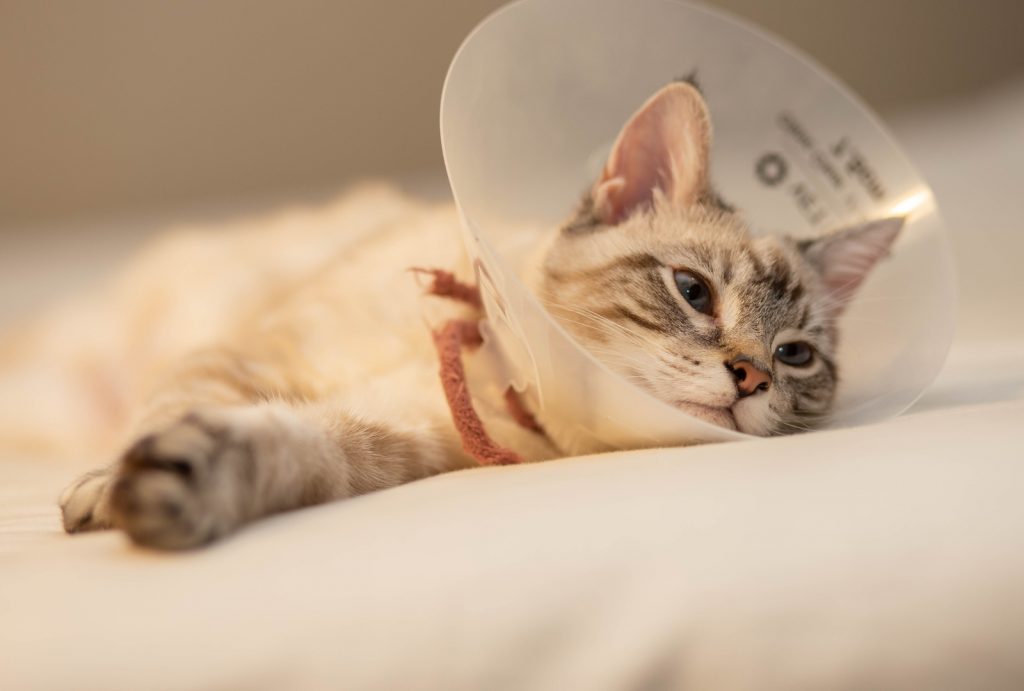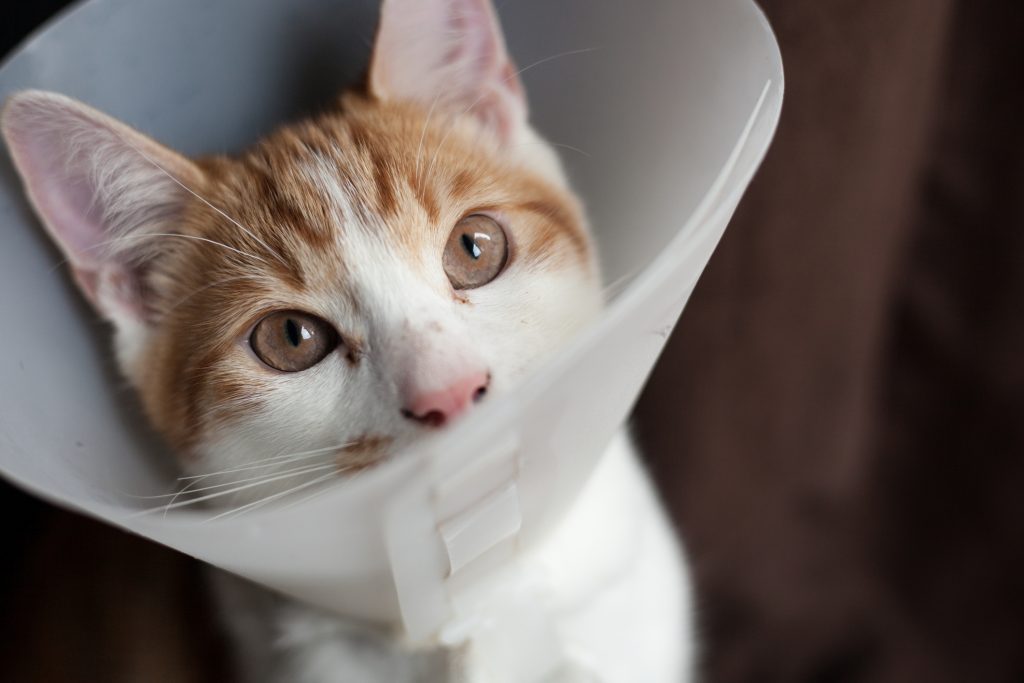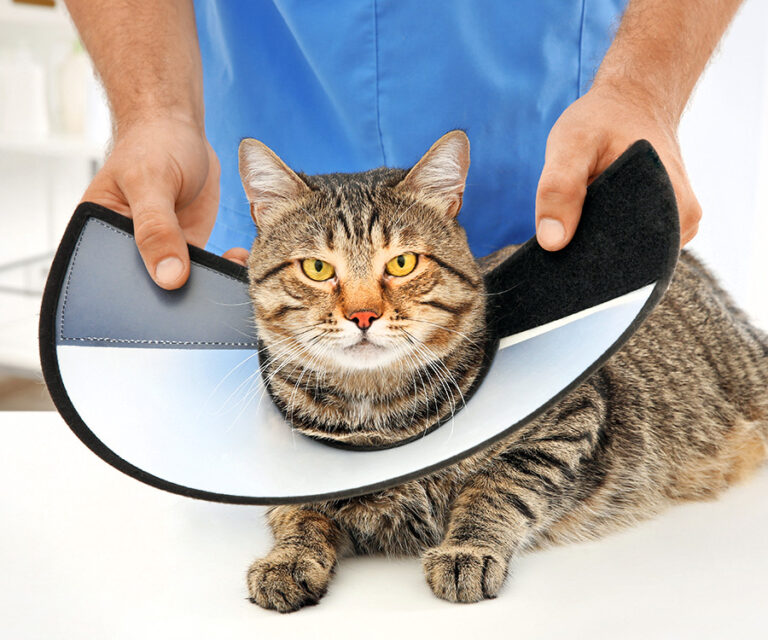No, a neutered male cat cannot penetrate and impregnate a female cat because neutering involves the removal of the testicles, which are responsible for producing sperm and the male hormone testosterone. Neutering eliminates a male cat’s ability to reproduce.
Cat neutering is a surgery where a male cat’s testicles are removed, which is also called castration. People do this to control the cat population, keep them healthy, and improve their behavior.
Neutering helps prevent unwanted litter of kittens and can reduce certain undesirable behaviors in male cats.
The Neutering Process of Male Cat
What happens during cat neutering?
Cat neutering is a routine surgical procedure performed by veterinarians. During the procedure, the veterinarian:
Administers anesthesia: The cat is placed under general anesthesia to ensure it feels no pain during the surgery.
Prepares the surgical area: The surgical site is cleaned and sterilized to prevent infection.
Makes an incision: The veterinarian makes a small incision in the cat’s scrotum to access the testicles.
Removes the testicles: The testicles are carefully removed through the incision. This eliminates the source of sperm production and reduces the production of testosterone.
Closes the incision: The incision is closed with sutures or surgical glue.
Monitors recovery: The cat is closely monitored during the recovery process to ensure there are no complications from the surgery.
Behavioral changes in neutered male cats

Neutering can have several positive behavioral changes in male cats, including:
Reduced aggression: Neutered cats are often less aggressive towards other cats and animals, making them more amiable companions.
Decreased territorial marking: Unneutered males are prone to marking their territory with urine. Neutering reduces or eliminates this behavior in most cases.
Less roaming: Neutered males are less likely to roam in search of mating partners, which can help keep them safe from accidents and diseases.
Reduced yowling: Unneutered males can be noisy and yowl loudly to attract mates. Neutering can decrease this vocalization.
Improved litter box habits: Neutered cats tend to have better litter box habits, as they are less driven by hormonal urges to mark their territory.
Benefits of neutering for cat owners
There are several benefits of neutering for cat owners, including:
Population control: Neutering prevents unwanted litter, reducing the burden of finding homes for kittens and helping control the feline population.
Health benefits: Neutering reduces the risk of certain health issues, such as testicular cancer, and may lead to a longer and healthier life for your cat.
Behavior improvement: Neutering can make male cats more pleasant companions by reducing aggressive and territorial behaviors.
Reduced roaming: Neutered cats are less likely to roam and get into fights, reducing the risk of injuries and disease exposure.
Less noise: Neutered cats are quieter, making them more suitable for apartment living or close-knit neighborhoods.
Reproductive Anatomy After Neutering
An Overview of the male cat’s reproductive organs
Before discussing the changes that occur after neutering, it’s essential to understand the male cat’s reproductive anatomy:
Testicles: The two testicles produce sperm and the male hormone testosterone. They are located in the scrotum.
Seminal Vesicles: These glands produce seminal fluid, which nourishes and transports sperm.
Prostate Gland: The prostate gland contributes additional fluid to semen.
Changes in the reproductive system after neutering
After neutering, the primary change in the male cat’s reproductive system is the removal of the testicles. This surgical procedure eliminates the production of sperm and significantly reduces the production of testosterone. As a result:
Sperm Production Stops: Without testicles, the cat can no longer produce sperm, making it incapable of fathering kittens.
Reduced Testosterone: The drop in testosterone levels can lead to the cessation of male mating behaviors, such as the mounting and aggressive pursuit of females.
Changes in Accessory Glands: While neutering removes the testicles, it does not affect the other accessory glands (seminal vesicles and prostate). However, these glands become less active without the influence of testosterone.
Why do neutered cats still exhibit mating behavior?
Even though neutering eliminates most of the male cat’s reproductive capabilities and reduces mating-related behaviors, some neutered cats may still exhibit occasional mating behaviors for the following reasons:
Hormonal Residue: It can take some time for the residual testosterone to dissipate from the cat’s system after neutering completely. During this transitional period, some mating behaviors may persist.
Learned Behaviors: Some cats may have learned mating behaviors before neutering, and these behaviors can become ingrained habits that persist even after the hormonal drive has diminished.
Social or Environmental Factors: Neutered cats might still exhibit mating behaviors if they are exposed to unsprayed females in heat, as the scent and behavior of a female in estrus can trigger responses in males.
Mating Behavior in Neutered Male Cats
The Typical mating behaviors
Mating behaviors in cats are typically associated with the courtship and reproductive process. While neutered male cats no longer have the hormonal drive to reproduce, some may exhibit residual mating behaviors, which can include:
Mounting: Neutered males may occasionally mount other cats, objects, or even human legs as a form of play or dominance display. This behavior is not typically associated with sexual intent in neutered cats.
Kneading: Cats often knead with their front paws on soft surfaces, a behavior that can be reminiscent of the kneading action used by kittens to stimulate milk flow from their mother.
Vocalizations: Neutered males may make vocalizations, such as yowling or caterwauling, which are often associated with attracting females during mating. In neutered cats, these vocalizations may occur in response to environmental factors or stress.
Affectionate Behavior: Some neutered males may engage in affectionate behaviors that mimic courtship, such as head-butting or rubbing against other cats or people.
Factors that influence mating behavior in neutered males
Several factors can influence the expression of mating behaviors in neutered male cats:
Hormonal Residue: As mentioned earlier, it can take some time for the residual testosterone to dissipate from a neutered male’s system fully. During this transitional period, they may exhibit some mating behaviors.
Socialization and Early Learning: Cats that were not neutered at an early age or had previous exposure to mating behaviors before neutering may be more likely to continue exhibiting these behaviors.
Stress or Anxiety: Environmental stressors or anxiety can trigger various behaviors in cats, including those associated with mating. Changes in the cat’s environment, new additions to the household, or unfamiliar scents can be stressors.
Presence of Unspayed Females: The scent and behavior of an unspayed female in heat can trigger mating behaviors in neutered males, even though they cannot reproduce.
How do neutered male cats interact with female cats in heat?
When a female cat goes into heat (estrus), she emits specific pheromones and behaviors to attract males for mating. Neutered male cats may respond to these cues in several ways:
Increased Attention: Neutered males may become more attentive to the female in heat, following her around and showing heightened interest in her.
Vocalizations: Neutered males might vocalize more when they sense a female in heat, as they may be responding to her calls and scent.
Affectionate Behavior: Some neutered males may behave affectionately toward the female, including grooming her and displaying behaviors reminiscent of courtship.
Preventing Unwanted Mating Behavior of Male Cat

Strategies for managing and redirecting mating behaviors
Spaying and Neutering: The best way to stop cats from mating when you don’t want them to is to have females spayed, and males neutered when they’re young. This reduces their hormones and makes them not want to have babies.
Environmental Enrichment: Provide a stimulating environment with toys, scratching posts, and interactive play to mentally and physically engage your cat. This can help redirect their energy away from mating behaviors.
Positive Reinforcement: Reward desirable behaviors and redirect undesirable ones. For example, if your neutered male cat starts to display mounting behavior, gently remove him and redirect his attention to a toy or playtime.
Socialization: Teaching your cat to socialize when they’re young can help them learn to get along with others and reduce anxiety-related issues.
Consult with a Veterinarian or Behaviorist: If mating behaviors persist or become problematic, seek guidance from a veterinarian or animal behaviorist. They can provide tailored advice and potential behavior modification techniques.
Importance of responsible pet ownership
Responsible pet ownership prevents unwanted mating behavior and addresses related issues. This includes:
Spaying and Neutering: Ensuring that your cats are spayed or neutered prevents unwanted pregnancies and reduces the likelihood of roaming and aggression.
Safe Environments: Provide a safe and secure environment for your cats, especially if you have both intact and neutered animals. Keep intact females separate from males when they are in heat to prevent mating.
Identification: If your cat is not microchipped or does not wear a collar with identification, consider doing so in case they escape during mating-related activities.
Adopt Don’t Shop: Choose adoption from shelters or rescues instead of buying from breeders or pet stores. It can help decrease the number of homeless cats.
The option of reintroducing a neutered male to an intact female
Reintroducing a neutered male to an intact female should be approached with caution and typically is not recommended unless there are specific circumstances, such as for breeding purposes under the guidance of a responsible breeder. In most cases:
No Reproductive Intent: Neutered males cannot reproduce, so reintroducing them to an intact female will not result in kittens.
Stress and Conflict: Introducing a neutered male to an intact female in heat can be stressful for both cats. The female may become agitated due to the male’s persistent attention, and the male may become frustrated.
Health Risks: Health risks such as injuries or behavioral issues can be associated with attempting to mate an intact female with a neutered male.
FAQs
Can a neutered male cat still reproduce?
No, neutered male cats cannot reproduce because their testicles have been surgically removed, rendering them sterile.
Does neutering a male cat affect its sexual behavior?
Yes, Neutering typically reduces a male cat’s sexual behavior, including roaming, spraying, and aggressive mating behaviors.
Can a neutered male cat still have an erection?
Yes, neutered male cats can still have erections due to sexual arousal, but they cannot mate or reproduce.
Do neutered male cats still go into heat?
Male cats do not experience heat. Heat, or estrus, is a female cat’s reproductive cycle.
Can a neutered male cat impregnate a female cat?
No, neutered male cats cannot impregnate female cats because they lack the ability to produce viable sperm.
Will neutering a male cat prevent him from trying to mate with female cats?
Neutering significantly reduces a male cat’s desire to mate with female cats, making them less likely to exhibit such behaviors.
Can a neutered male cat have sexual intercourse?
No, neutered male cats are physically incapable of engaging in sexual intercourse due to the removal of their testicles.
Does neutering a male cat affect its libido?
Yes, neutering reduces a male cat’s libido, decreasing interest in mating.
Can a neutered male cat still show aggression toward other male cats?
Yes, neutered male cats still show aggression toward other male cats, although neutering can reduce the level of aggression.
Can neutering a male cat change its personality?
Yes, neutering generally results in a calmer and more docile demeanor in male cats. They are less likely to display aggressive and territorial behaviors.
Is neutering a male cat a permanent solution to prevent reproduction?
Yes, Neutering is a permanent solution to prevent male cats from reproducing. Once neutered, they cannot father kittens.
Conclusion
Neutering is a vital tool in controlling the feline population. By spaying and neutering our cats, we can significantly reduce the number of unwanted kittens born each year.
This not only eases the burden on animal shelters and rescue organizations but also helps prevent the suffering of homeless cats and kittens.
Neutering also reduces the spread of feline-related diseases and reduces the strain on local ecosystems by controlling feral cat populations.
Ultimately, cat neutering is a responsible and essential choice for pet owners. It prevents unwanted litter, reduces mating behaviors, and contributes to the overall welfare of cats and the broader community.

